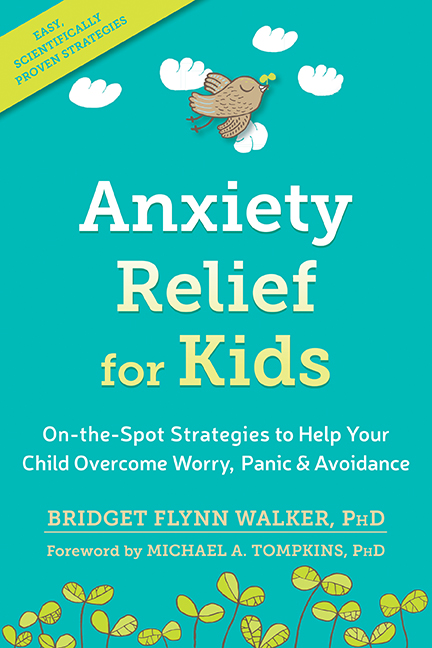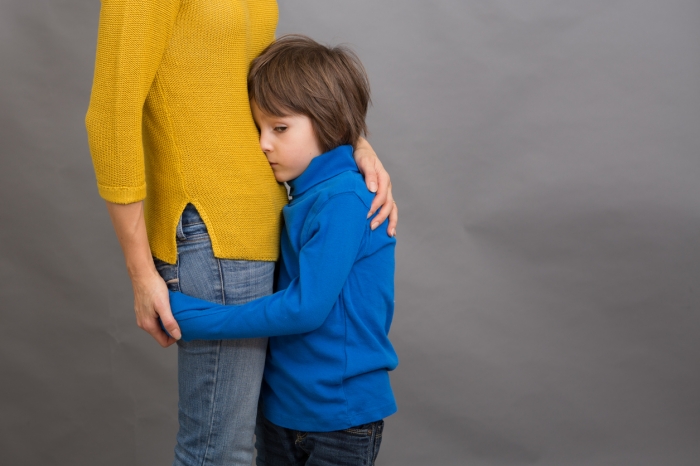By Bridget Flynn Walker, PhD, author of Anxiety Relief for Kids
Anxiety disorders are the most common psychological problem that children experience; yet, quite often, parents, pediatricians, and even many mental health professionals have difficulty identifying anxiety as the root of a child’s presenting problems. If there is one thing I know as a child psychologist, it’s that anxiety problems often don’t look like what you would expect. In my book, Anxiety Relief for Kids, I offer these visible and less visible signs of anxiety to help parents identify their children’s behavior:
Visible Signs of Anxiety
-
Physical distress (shaking, crying, hyperventilating, screaming, etc.)
-
Fleeing, escaping
-
Outright statements of anxiety (“I’m afraid the house will burn down tonight while I’m asleep.”)
-
Outright questions expressing fears (“What if you get in a car accident when you go out?”)
-
Refusal to engage in activities that cause distress
-
Extreme distress upon contact with feared object (dogs, birds, planes, extreme weather, contaminants, etc.)
-
Refusal to be alone or without a parent
Less Visible Signs of Anxiety
-
Clingy behavior
-
Irritability
-
Avoidance behavior
-
Complaints of physical illness
-
Reassurance-seeking behavior
-
Argumentative behavior
-
Reluctance to try new things (activities, foods, places, routines, etc.)
-
Extreme shyness, sensitivity
-
Slowness (relative to others of the same age), procrastination
-
Overly cautious behavior, indecision
-
Exacting standards
-
Sleep difficulties (refusal to sleep alone or go on sleepovers)
-
Physical aggression
-
Threats of suicide to avoid anxiety-producing situations
As you can see, anxiety (often expressed as fear) is multifaceted. On the one hand, it can look obvious. On the other, a kid who gets straight A’s, studies excessively, avoids extracurricular activities such as play dates, sports, and other leisure pastimes due to fear of having insufficient time for homework may seem like a model child. Yet, they may chronically doubt their abilities and live in fear of performing below the unrealistic standards that they set for themselves. They may repeatedly share with their parents that they never feel prepared for tests, or that they are certain they will fail or have insufficient time to prepare. The difference between a child who has normal anxiety in this situation and those with anxiety disorders is that for the latter, these behaviors persist in spite of the child’s stellar performances.
The most prevalent parental issues I see in my practice working with children who have anxiety disorders tend to present themselves in family units in the following ways:
1. Anxiety responses often seem irrational or greatly overblown to parents. The example just discussed falls into this category: every time an anxious child has a test or a lot of homework, they fret about getting it done, always completes all of their work, and does extremely well—yet never seems to learn that their fears never materialize.
2. The nature of anxiety itself also confounds many parents. Anxiety results when a child faces a situation in which they fear some undesirable outcome. Such situations and feared outcomes vary among children. For example, a child with social anxiety might fear raising their hand in class (the situation) because they worry that their voice will shake, and their classmates will then think they’re weird (the feared consequence). A child with obsessive-compulsive disorder (OCD); a type of anxiety-related disorder) who suffers from contamination obsessions might fear coming into contact with germy surfaces (situation) because they will know that yucky germs are on them and hence they feel worried, tense, and distracted (the feared consequence). As a parent, you may be able to identify the various situations that trigger worry and fear in your child. Quite often, however, what is more readily observable are the various behaviors that children resort to in order to quell their fears. These behaviors often include: avoidance of situations, escaping/leaving situations that trigger worry, excessive reassurance seeking, and habits a child adopts to reduce distress (like hand washing or checking).
3. Anxiety comes in spikes. Everything can be going just fine, and all of a sudden, your child finds themselves in a situation that triggers worry and fear. Over time, the spike passes and things seem okay until they find themselves in another situation that engenders feared consequences.
4. Anxiety symptoms tend to come and go. Some days, weeks, months or even years may seem anxiety free, while others may be filled with fear and worry. Sometimes this is related to increased exposure to situations that trigger anxiety, such as school, sleepaway camp, etc. Other times, there are not readily identifiable reasons.
5. The predisposition to develop anxiety problems runs in families. If there is a family history of anxiety, your child is more likely to have problems with anxiety than a child without such a genetic background.
While the presence of some anxiety in a child is completely normal, if it reaches levels that cause distress or interfere with day-to-day activities and/or cause upheaval in the family, your child needs help. Anxiety problems affect at least 25 percent of the population, and, left untreated, can exact high costs on the sufferer and family. Quality of life can be diminished, academic performance affected, and a child’s sense of self can be altered.
But there is good news: anxiety is treatable.
Accurately identifying anxiety is the first step in finding relief for your child. You can start to help your child conquer their anxiety right away by learning more. Cognitive behavioral therapy (CBT) is the gold standard in effectively managing anxiety problems, and the good news is that it’s easy to understand and integrate into your life.
 Bridget Flynn Walker, PhD, is author of Anxiety Relief for Kids, and a practicing psychologist in San Francisco, CA. For the last fifteen years, she has focused exclusively on assessing and treating children, adolescents, and adults with anxiety disorders, and on training other mental health professionals to do the same using cognitive behavioral therapy (CBT).
Bridget Flynn Walker, PhD, is author of Anxiety Relief for Kids, and a practicing psychologist in San Francisco, CA. For the last fifteen years, she has focused exclusively on assessing and treating children, adolescents, and adults with anxiety disorders, and on training other mental health professionals to do the same using cognitive behavioral therapy (CBT).


 2024 Peace Playbook: 3 Tactics to Avoid Clashes with Your Partner
2024 Peace Playbook: 3 Tactics to Avoid Clashes with Your Partner